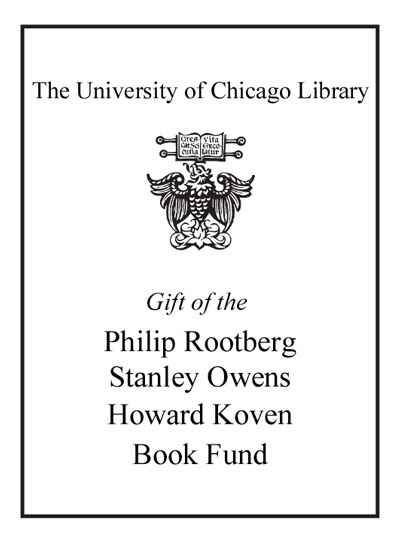What makes time special? /
Saved in:
| Author / Creator: | Callender, Craig, 1968- author. |
|---|---|
| Edition: | First edition. |
| Imprint: | Oxford : Oxford University Press, 2017. |
| Description: | xvii, 343 pages : illustrations ; 24 cm |
| Language: | English |
| Subject: | |
| Format: | Print Book |
| URL for this record: | http://pi.lib.uchicago.edu/1001/cat/bib/11330119 |
Table of Contents:
- Acknowledgments
- List of Figures
- List of Boxes
- 1. The Problem of Time
- 1.1. Manifest Time
- 1.1.1. Now
- 1.1.2. Flow
- 1.1.3. Past/Future asymmetry
- 1.1.4. Is manifest time universal?
- 1.2. Physical Time
- 1.2.1. No manitest time
- 1.2.2. What makes time special?
- 1.3. The "Two Times" Problem
- 1.4. From There to Here
- 2. Lost Time: Relativity Theory
- 2.1. Classical Physics
- 2.1.1. Recovering space and time
- 2.1.2. Classical ideal clocks and manifest time
- 2.1.3. Trautman-Cartan theory
- 2.2. Relativity
- 2.3. Where's Time?
- 2.4. Minkowski Spacetime
- 2.5. Lorentzian Time
- 2.6. Outside Minkowski: Domes, Donuts, and Diamonds
- 2.7. Conclusion
- 3. Tearing Spacetime Asunder
- 3.1. Cauchy Time
- 3.2. "Unique" Time Functions
- 3.3. Time, Stuff, and Laws
- 3.4. Conclusion
- 4. Quantum Becoming?
- 4.1. Quantum Mechanics
- 4.2. Popper's Experiments Crucis
- 4.2.1. Quantum preferred frames and time
- 4.2.2. Caveats and alternatives
- 4.2.3. The coordination problem
- 4.3. Quantum Becoming via Collapses?
- 4.4. Conclusion
- 5. Intimations of Quantum Gravitational Time
- 5.1. The Best of Times: "Asynchronous Becoming" in Causal Sets
- 5.1.1. The basic kinematics of CST
- 5.1.2. Taking growth seriously
- 5.2. The Worst of Times: Disappearing Time in Canonical Quantum Gravity
- 5.2.1. Semiclassical time
- 5.2.2. Justifying the approximations
- 5.3. Conclusion
- 6. The Differences Between Time and Space
- 6.1. The Project Reconceived
- 6.2. Time in Physics
- 6.2.1. The metric
- 6.2.2. Dimensionality
- 6.2.3. Mobility asymmetry
- 6.2.4. Direction of time
- 6.2.5. Natural kind asymmetry
- 6.3. The Fragmentation of Time
- 6.4. Conclusion
- 7. Laws, Systems, and Time
- 7.1. System Laws and Time
- 7.2. Time is the Great Informer
- 7.3. Binding Time
- 7.3.1. One-dimensionality
- 7.3.2. Closed timelike curves
- 7.3.3. The direction of time
- 7.3.4. Natural kind asymmetry
- 7.4. Metaphysical Variations
- 7.5. Questions and Connections
- 7.6. Conclusion
- 8. Looking at the World Sideways
- 8.1. Strength and Well-posed Cauchy Problem
- 8.2. The Worlds
- 8.3. Proposal
- 8.4. The Argument
- 8.5. Illustration
- 8.6. Is It Time?
- 8.7. Turning Pages in Non-temporal Direction
- 8.7.1. Pages of light
- 8.7.2. Pages of time
- 8.8. Conclusion
- 9. Do We Experience the Present?
- 9.1. Metaphysics of Time
- 9.2. The Problem of the Presence of Experience
- 9.3. The Temporal Knowledge Argument
- 9.4. From Metaphysics to Psychology: Perceived Synchrony
- 9.4.1. Temporal ventriloquism
- 9.4.2. Temporal recalibration
- 9.4.3. Comments
- 9.5. Interlude: Measuring Subjective Simultaneity
- 9.6. Exploding the Now
- 9.7. Does Synchrony Pop Out?
- 9.8. Conclusion
- 10. Stuck in the Common Now
- 10.1. Disagreement and the Case of PH
- 10.2. Manufacturing the Now: Signals, Speed, and Stamps
- 10.2.1. Time stamps not needed
- 10.2.2. The common now
- 10.3. Wiggling in Time vs Wiggling in Space
- 10.4. Conclusion
- 11. The Flow of Time: Stitching the World Together
- 11.1. Sharpening Focus
- 11.2. Meet IGUS
- 11.3. Getting IGUS Stuck in Time
- 11.4. Outfitting IGUS
- 11.4.1. Sensing motion and change
- 11.4.2. Specious present
- 11.4.3. Felt duration
- 11.5. Memories and Flow
- 11.6. The Enduring Witness
- 11.7. From Flowing Selves to Animated Time
- 11.8. Temporal Decentering and the Self
- 11.9. The Acting Self
- 11.10. The Explanation of Passage
- 11.11. Conclusion
- 12. Explaining the Temporal Value Asymmetry
- 12.1. "Thank Goodness That's Over"
- 12.2. The Proximal/Distant Asymmetry
- 12.3. The Humean Solution
- 12.4. The Knowledge Asymmetry
- 12.5. The Affect Asymmetry
- 12.6. Explaining the PF Asymmetry
- 12.7. Other Temporal Biases
- 12.8. Explaining Other Time Biases
- 12.9. Conclusion
- 13. Moving Past the ABCs of Time
- 13.1. Analytic Philosophy of Time: A Potted and Biased History
- 13.2. The Explanatory Challenge
- 13.2. The ABCs of Physics
- 13.4. Eliminating Tense?
- 13.5. Conclusion
- 14. Putting It All Together
- 14.1. Common Structure
- 14.2. A Unified Flowing Now
- 14.3. Animals
- 14.4. An Illusion?
- 14.5. Conclusion
- Bibliography
- Index

